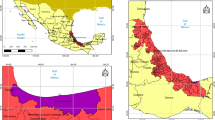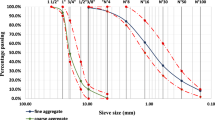Conclusions
-
1.
Pipe cooling of the concrete was successfully employed in the construction of the Krasnoyarsk hydroelectric station, being an, effective means for controlling the temperature, conditions of the mass concrete.
-
2.
By employing artificial cooling of the concrete and using cements of average thermal properties for the concrete it was possible to substantially reduce fissuring in the mass concrete from 1964.
-
3.
Under the conditions of the Krasnoyarsk hydroelectric station construction, the most effective pipe spread for the cooling coils was 1.5×3.0 m. When placing the concrete in high blocks (over 3 m) on an “old” base in summer, in order to obtain a quicker reduction in temperature on the concrete in the second stage of cooling (to bring the concrete temperature down to the joint sealing temperature), smaller spaces were necessary, between the cooling pipes both horizontally and vertically.
-
4.
The use of a pipe cooling system for lowering the maximum concrete temperature with low rate of growth of the structure and block height less than 2 m has little effect and can be recommended only on the basis of the conditions of block preparation for the second stage of cooling, when the concrete temperature in the columns must be lowered sufficiently for carrying out high-grade grouting of the joints, between the blocks.
Similar content being viewed by others
Literature Cited
M. S. Lamkin, “Practical method for calculating cooling of concrete masses by a system of pipes,” Nauchno-Tekhnicheskii Informatsionnyi Byulleten”, No. 2, Leningradskogo Politekhnicheskogo Instituta (1959).
B. K. Frolov, Controlling the Temperature Conditions of the Concrete in the Construction of Dams [in Russian], Izd-vo “Energiya” (1964).
VSN-02-64, Tentative Instructions for Rendering Monolithic Concrete Hydraulic Engineering Structures Erected in Areas of Severe Continental Climate [in Russian], Izd-vo “Energiya” (1964).
G. N. Danilova and N. A. Buchko, “Method for calculating the temperature conditions with pipe cooling of dam concrete masonry,” Gidrotekh. Stroitel'., No. 5 (1965).
A. P. Epifanov and A. P. Dolmatov, “Concreting the dam of the Krasnoyarsk hydroelectric station with high blocks,” Energeticheskoe Stroitel'stvo, No. 6 (1966).
A. P. Epifanov and I. A. Petrova, “Requirements on temperature conditions of massive blocks of columnar section poured on a concrete base of variable ages”, Gidrotekh. Stroitel'., No. 8 (1967).
Additional information
Translated from Gidrotekhnicheskoe Stroitel'stvo, No. 11, pp. 6–9, November, 1968.
Rights and permissions
About this article
Cite this article
Dolmatov, A.P., Neidlin, S.Z. Temperature control of the massive concrete of the Krasnoyarsk hydroelectric station dam. Hydrotechnical Construction 2, 956–960 (1968). https://doi.org/10.1007/BF02376683
Issue Date:
DOI: https://doi.org/10.1007/BF02376683




